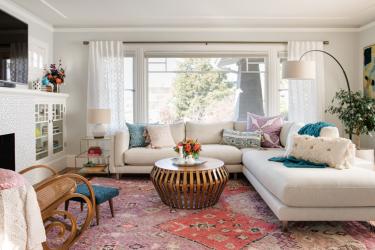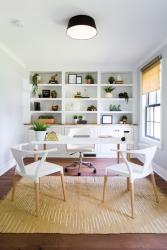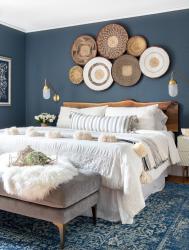A Base to Build On: Starting with a simple base color for your bohemian-style room will keep the space from seeming too busy or cluttered. Warm and earthy tones will pair well with bright accents, and they will also complement the botanical staples in bohemian design. Remember that this design style mimics your own vision of an oasis, so choose a neutral that you’ll love for years to come.
Artistic Trinkets: For a nomadic and well-traveled feel, add some of your favorite keepsakes and souvenirs from past trips; these will give your space a personalized touch and serve as bright conversation pieces. Not a world traveler? Take a trip to your local antique shop and find interesting treasures to display.
The Bolder the Better: From pinks to purples to oranges and greens, vibrant colors are a must-have in bohemian design. If you’re having trouble knowing where to start, deep jewel tones can instantly make a space feel luxe and comforting. Have fun with your color combinations, but make sure to keep them consistent!
Staying Grounded: When it comes to choosing furniture for authentic bohemian design, the closer to the floor the better! Start with a comfortable plush rug for floor seating and add poufs, ottomans and low-backed sofas with plenty of colorful throw cushions of different sizes and styles. Visit your local antique shop to find time-worn, well-loved pieces to create a perfect entertaining space on a budget.
Play with Pattern: Layering patterns bursting with color adds a decadent note to any bohemian area. Have fun picking patterned rugs, cushions and throws with contrasting shapes, scales and styles to make each room your own. Afraid of overdoing it? Keeping a consistent color scheme in mind helps prevent a room from feeling disjointed; choose a main dark, luxurious color (such as burgundy or emerald green) and layer complementary colors on top to keep it cohesive.
Love Your Layers: Layering colors, patterns and textures makes a compelling visual impact, and it can also help dress up or conceal imperfections on distressed antique furniture. Bohemian design offers layers of interest, revealing new and unique design choices on the second, third and fourth glances around a room.
Elevating Vegetation: Create a relaxed vibe in your space with plenty of plant life. Botanicals are an affordable way to connect with nature inside your home and cultivate a sense of care. They also add a pop of color without going over the top! Plant indoor greenery and flowers in colorful pots that coordinate with other accent colors to add more pattern. You can choose hanging baskets or more ornate and sculptural planters; the possibilities are endless!
Reflection: With trinkets and furniture and accessories galore, adding mirrors and reflective surfaces can make a bohemian space feel brighter and more spacious. Additionally, they can add a focal point amidst a room with many areas of interest. Metallic lanterns and Moroccan lights hung low will add to your space’s sense of comfort and visual interest.
---
A local interior designer’s perspective on Bohemian design.
Design Style is an interior design company based in St. Louis and run by Dottie Eaton.
What feeling does Bohemian style design aim to evoke? Bohemian style speaks of a carefree, gypsy-like space where one walks in and immediately feels relaxed and inspired. Think of a traveler going on a trip and then bringing their treasures home to mix together in that just oh-so-right way.
What is the most difficult part of decorating in this style? The rooms look inviting and non-fussy, but they are actually a well thought-out use of artistic principles. Textures, patterns and colors all combine together to create an artistic comfortable space that mixes different cultural styles and design styles with no rules and regulations, but they do require thought and an artistic eye.
What type of clients typically gravitate toward Bohemian style interiors? The style was started by artists, writers, poets and vagabonds in Paris in the early nineteenth century seeking a creative lifestyle surrounded by beauty. People that are now drawn to this style are usually non-conformist and creative people, wanting their space to reflect these elements.











